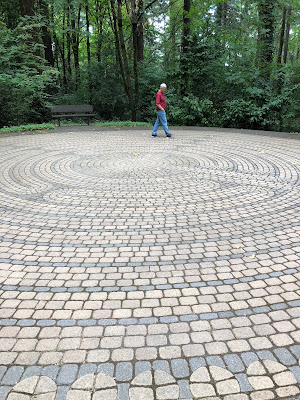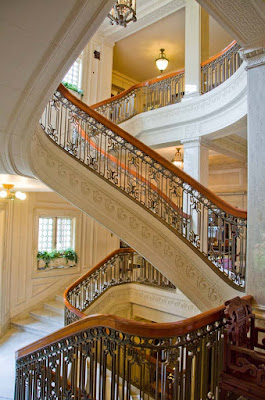Host to more than
300,000 visitors a year, the National Sanctuary of our Sorrowful Mother, more popularly known
as The Grotto, is a multi-level Catholic outdoor shrine and sanctuary with the main entrance located at NE 85th Avenue and Sandy Boulevard in Portland, Oregon. Parking
and admission to the lower level is free to the public.
Constructed in 1924, the sanctuary
covers 62 acres and displays more than 100 statues as well as reflection ponds,
prayer labyrinth, meditation chapel and inspirational views.
There are two levels once inside the Grotto. The lower level includes an imposing cave carved out of the 110-foot basalt cliff and serves as an outdoor cathedral and wedding venue.
There are two levels once inside the Grotto. The lower level includes an imposing cave carved out of the 110-foot basalt cliff and serves as an outdoor cathedral and wedding venue.
 |
| Outdoor Cathedral |
The marble statue in the center of the cave is a
replica of Michelangelo’s depiction of Mary cradling Jesus’ crucified body, and is surrounded
by flowers and candles.
 |
| Michelangelo's "Mary cradling Jesus' crucified body" housed at the Vatican. |
 |
| Chapel of Mary |
 |
| Inside Chapel of Mary |
From May through October, mass is also held outdoors in the Grotto Plaza — an expansive, pew-lined square facing the Grotto Cave.
 |
| Grotto Plaza |
A tranquil trail is lined with towering moss laden trees, Along the walk, elaborately carved sculptures illustrate the 14 Stations of the Cross.
There are several thousand feet of
trails throughout the 62 acre complex. The Smithsonian Institution has 23
statues and memorials registered at The Grotto. The day of my visit there was a
wedding in progress. Beautiful setting.
 |
| View of Meditation Chapel from below |
 | ||
| Entrance to the Meditation Chapel |
The upper level also includes the Peace Garden, featuring a trail that meanders through mossy fir trees and flowerbeds and circles a serene reflection pond.
Another path will lead to a labyrinth, a circle of crimson bricks surrounded by wooden benches. A peaceful prayer walk opportunity.
 |
| Prayer Labyrinth |
In the late spring and early summer, the botanical gardens are in full bloom, overflowing with rhododendrons, daylilies, impatiens, roses and daisies.
Another peaceful path weaves through St. Joseph Grove’s towering trees to St. Anne’s Chapel, a small brick building built in 1934 that houses several pastel-colored paintings.
The monastery house looks like a small, stone castle overseeing the grounds.
This is well worth the stop. For more information check out The Grotto.































































